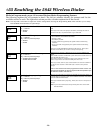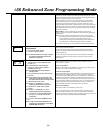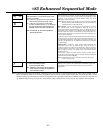
–31–
✻
80 Device Programming Menu Mode
Powerline Carrier devices (eg., X-10 brand devices) are programmable switches that can be used to perform
many different functions. They can be used to turn lights on and off, control sounders, or for status
indications. In this system, each device must be programmed as to how to act (ACTION), when to activate
(START), and when to deactivate (STOP). Each of these is described below.
The control supports a total of 8 output devices.
The 1332X10 transformer sends signals from the control panel through the premises AC wiring to the
Powerline Carrier Devices (which are plugged into AC outlets). Devices plugged into Powerline Carrier
Devices can then be made to perform various functions in response to commands entered at the keypads in
the security system.
U
L
Powerline Carrier Devices are not UL Listed for fire or burglary functions and are intended for home automation.
Programming Options Defined
The following will help you understand the programming of output devices when using ✻80 and ✻81 modes.
ACTION The "ACTION" of the device is how the device will respond when it is activated by the
"START" programming. There are four different choices of actions:
• ACTIVATE for 2 SECONDS and then reset.
• ACTIVATE and REMAIN ACTIVATED until stopped by some other event.
• PULSE ON and OFF until stopped by some other event.
• NOT USED when the device is not used.
START The "START" programming determines when and under what conditions the device will
be activated. The following START options are available:
Start by Event
1. Event is the condition (alarm, fault, trouble) that must occur to a zone or group of
zones (zone list) in order to activate the device. These conditions apply only when a
zone list is used. The different choices for "EVENT" are listed below and in the
“Programming Powerline Carrier Devices” paragraph that follows.
• ALARM Device activates upon any alarm in an assigned zone in the zone list.
• FAULT Device activates upon any opening or short in an assigned zone in the zone list.
• TROUBLE Device activates upon any trouble condition in an assigned zone in the zone list.
• NOT USED Device action is not dependent upon one of the above events.
2. A zone list is a group of zones to which the “EVENT” applies in order to activate a
particular device. Note that there are a total of 3 output device-related zone lists
that can be programmed in
✻81 menu mode; when the selected EVENT (alarm, fault
or trouble) occurs in any zone in the selected “Start” ZONE LIST (1, 2, or 3),
activation of the selected device will START.
Start by Zone Type or System Operation
• If a system operation, such as “DISARMING” or “ANY FIRE ALARM,” is to activate
the device, the appropriate choice would also be entered under the “ZONE TYPE”
option. “ZONE TYPE” is used independently of the “EVENT/ZONE LIST”
combination.
• If a "ZONE TYPE" is chosen, any zone of that response type going into alarm,
trouble, or fault will cause the device to activate as selected in "ACTION.” If the same
“ZONE TYPE” is also chosen for the STOP programming, any zone of that type that
restores will de-activate the device.
• If a "SYSTEM OPERATION" is chosen (e.g., End of Exit Time), that operation will
cause the device to activate as selected in "ACTION.” The different choices for
"ZONE TYPE" and "SYSTEM OPERATION" are listed in the “Start zone type”
paragraphs later in this section, and in the Programming Form.


















